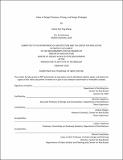| dc.contributor.advisor | Takehiko Nagakura and Andrea Chegut. | en_US |
| dc.contributor.author | Zhang, Shane Xue Ying. | en_US |
| dc.contributor.other | Massachusetts Institute of Technology. Department of Architecture. | en_US |
| dc.contributor.other | Massachusetts Institute of Technology. Center for Real Estate. Program in Real Estate Development. | en_US |
| dc.date.accessioned | 2021-02-19T20:13:06Z | |
| dc.date.available | 2021-02-19T20:13:06Z | |
| dc.date.copyright | 2020 | en_US |
| dc.date.issued | 2020 | en_US |
| dc.identifier.uri | https://hdl.handle.net/1721.1/129841 | |
| dc.description | Thesis: M. Arch. in Real Estate Development, Massachusetts Institute of Technology, Department of Architecture, February, 2020 | en_US |
| dc.description | Thesis: S.M. in Real Estate Development, Massachusetts Institute of Technology, Program in Real Estate Development in conjunction with the Center for Real Estate, February, 2020 | en_US |
| dc.description | Cataloged from student-submitted thesis. | en_US |
| dc.description | Includes bibliographical references (page 45). | en_US |
| dc.description.abstract | Where is the value of design? Clients who are using buildings to solve societal economic needs rely heavily on real estate asset valuation models to guide their decision-making process; however, these asset valuation models often oversimplify the asset and only attempts to capture the crudest elements of the building (in most cases, only the square footage of the building is represented). Such crude abstraction of the asset results in the client's over-emphasis on elements that are represented within the valuation model as key value drivers for a project (e.g. the square footage). As a result, architects are often confronted with the challenge of mediating between their design interventions and the client's value-driven design approach. The result of this misalignment of design approaches are suboptimal design and economic outcomes. | en_US |
| dc.description.abstract | As an attempt to address this misalignment, I've investigated twenty internal and external architectural features such as external materiality, internal materiality, column spacing, and the number of building entrances to see whether there are architectural design features that are statically and economically significant in contributing to the value of the building. The intention is to identify elements where consistent financial value can be documented within design practice. There is limited data on design features so I chose to focus on the New York City commercial office market. While this represents a small subset of the entire real estate market, it has allowed the research to derive some key insights from an otherwise extremely opaque market. I documented and investigated twenty design features. Twelve of these architectural features were found to be statistically and economically significant in contributing to pricing differentials relative to their building peers. | en_US |
| dc.description.abstract | These results suggest that there is a significant impact of interior and exterior architectural design interventions that help to create relative value differential for commercial office buildings. | en_US |
| dc.description.statementofresponsibility | by Shane Xue Ying Zhang. | en_US |
| dc.format.extent | 45 pages | en_US |
| dc.language.iso | eng | en_US |
| dc.publisher | Massachusetts Institute of Technology | en_US |
| dc.rights | MIT theses may be protected by copyright. Please reuse MIT thesis content according to the MIT Libraries Permissions Policy, which is available through the URL provided. | en_US |
| dc.rights.uri | http://dspace.mit.edu/handle/1721.1/7582 | en_US |
| dc.subject | Architecture. | en_US |
| dc.subject | Center for Real Estate. Program in Real Estate Development. | en_US |
| dc.title | Value in design? Features, pricing, and design strategies | en_US |
| dc.type | Thesis | en_US |
| dc.description.degree | M. Arch. in Real Estate Development | en_US |
| dc.description.degree | S.M. in Real Estate Development | en_US |
| dc.contributor.department | Massachusetts Institute of Technology. Department of Architecture | en_US |
| dc.contributor.department | Massachusetts Institute of Technology. Center for Real Estate | en_US |
| dc.identifier.oclc | 1237108426 | en_US |
| dc.description.collection | M.Arch.inRealEstateDevelopment Massachusetts Institute of Technology, Department of Architecture | en_US |
| dc.description.collection | S.M.inRealEstateDevelopment Massachusetts Institute of Technology, Program in Real Estate Development in conjunction with the Center for Real Estate | en_US |
| dspace.imported | 2021-02-19T20:12:36Z | en_US |
| mit.thesis.degree | Master | en_US |
| mit.thesis.department | Arch | en_US |
| mit.thesis.department | RED | en_US |
